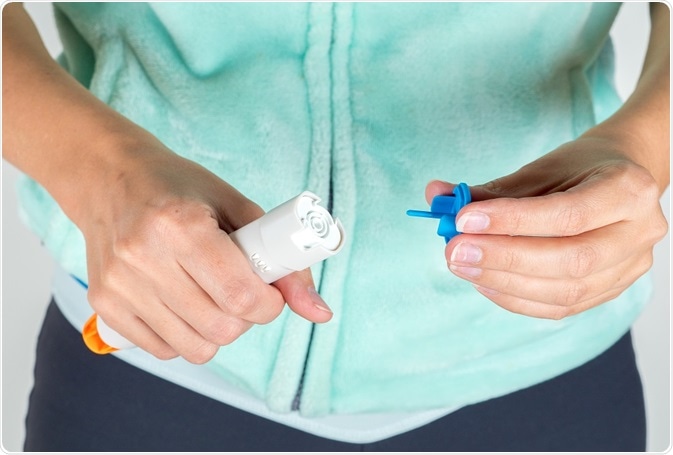When Should an Adrenaline Auto-Injector be Used?
An adrenaline auto-injector is an emergency treatment for anaphylaxis; serious and potentially fatal allergic reaction to insect stings, medicines, or food, among others.

Credit: Alexey Smolyanyy/Shutterstock.com
Anaphylaxis is an inappropriate inflammatory reaction to a particular substance, or allergen. Overreaction to a stimulus can lead to the release of chemicals, which can cause the body to go into a state of shock. This is called an anaphylactic shock and requires immediate medical treatment using an adrenaline auto-injector.
The most common allergens include insect stings from bees and wasps, insect bites from mosquitoes, certain foods like peanuts, and medicines. Since the onset of anaphylaxis is very quick, it can be fatal, so requires urgent treatment.
Signs and symptoms of anaphylaxis
An allergic reaction has a wide range of signs and symptoms. These include swollen lips, eyes and face, itchy or tingling sensation in the mouth, an itchy skin rash, hives and abdominal cramps.
But an anaphylactic reaction is severe and potentially life-threatening. The signs and symptoms of anaphylaxis are swelling in the throat, difficulty swallowing, hoarse voice, persistent cough, and swollen tongue.
The other symptoms include wheezing, noisy breathing, difficulty in breathing, dizziness, pallor, becoming suddenly sleepy, collapse, and falling unconscious.It is crucial to know the signs and symptoms of an anaphylactic reaction to determine when an adrenaline auto-injector is needed.
When should an adrenaline auto-injector be used?
Adrenaline falls in the sympathomimetic type of medicines. These drugs are used to treat an extreme form of an allergic reaction called anaphylaxis.Anaphylaxis is a medical emergency. An anaphylactic reaction can be fatal and the severity of each reaction is unpredictable.
Adrenaline is the drug of choice to treat the condition. People who have experienced a severe anaphylactic reaction in the past should carry an auto-injector containing adrenaline or epinephrine. This means that if ever another bout of an anaphylactic reaction happens again, the medicine is readily available.
A delay in using epinephrine in anaphylactic attacks may lead to death. Epinephrine, commonly known as adrenaline, works to reverse the potentially fatal symptoms. If you have had a severe allergic reaction in the past, take adrenaline as soon as you suspect that you had an exposure to something you are allergic to.
When you feel the common symptoms such as shortness of breath, coughing, a thready pulse, rashes, and tightness in the throat, don’t hesitate to use your adrenaline auto-injector. Keep in mind to carry two doses at all times to make sure you have a reserved dose if the first one does not work.
Each adrenaline auto-injector device is different
It is important to know that each adrenaline auto-injector is used differently, depending on the manufacturer instructions. For patients, it is vital to get training or a demonstration from your healthcare provider on the proper way the device should be handled, stored and used.
When you don’t use the device properly, the risk of injecting it into the wrong parts of the body increases. Epinephrine, when injected into the hands and fingers, may lead to nerve damage since the drug causes vasoconstriction of the vessels.
Inject the adrenaline auto-injector in the right location
The adrenaline auto-injector should be injected intramuscularly on the anterolateral aspect of the thigh. That is the area of muscle on the outer thigh. Accidentally injecting the drug into the veins or arteries is dangerous. It could lead to bleeding in the brain or cerebral hemorrhage due to the sudden increase in blood pressure.
How to use an adrenaline auto-injector
If a person is having an anaphylactic attack, you can provide first-aid immediately to prevent fatal complications. Make sure that the patient is lying flat or sitting down when he or she has trouble breathing. Administer the auto-injector depending on the drug label. Inject it on the outer part of the thigh. After administration, call for help or for an emergency responder.
Even if the patient’s condition is improving, always call for an ambulance for further evaluation. This will prevent another bout of allergic reaction.After giving the drug, position the patient’s legs higher than the body to maintain blood flow. If the first dose does not seem to work, administer the second dose at about 5 to 15 minutes after the first one. If the patient has stopped breathing, perform basic life support or cardiopulmonary resuscitation (CPR).
Anaphylactic shock can take lives if prompt medical attention is not given. For healthcare providers, having a readily available stock of adrenaline auto-injectors in clinics, schools, and community centers is vital.
If your child is prone to having severe allergic reactions, you should always let your child carry at least two doses of the drug. Being prepared for the worst is important to prevent the fatal complications associated with an anaphylactic shock.
Sources:
- http://www.aaaai.org/conditions-and-treatments/allergies/anaphylaxis
- assets.publishing.service.gov.uk/…/…_auto_injectors_in_schools.pdf
- acaai.org/allergies/allergy-treatment/epinephrine-auto-injector
- www.allergyuk.org/…/Adrenaline_Auto-Injectors_original.pdf
Further Reading
- All First Aid Content
- How to Perform CPR
- What is an Adrenaline Auto Injector?
- Alcohol Poisoning: What To Do
- Shock First Aid
Last Updated: Feb 26, 2019

Written by
Angela Betsaida B. Laguipo
Angela is a nurse by profession and a writer by heart. She graduated with honors (Cum Laude) for her Bachelor of Nursing degree at the University of Baguio, Philippines. She is currently completing her Master's Degree where she specialized in Maternal and Child Nursing and worked as a clinical instructor and educator in the School of Nursing at the University of Baguio.
Source: Read Full Article